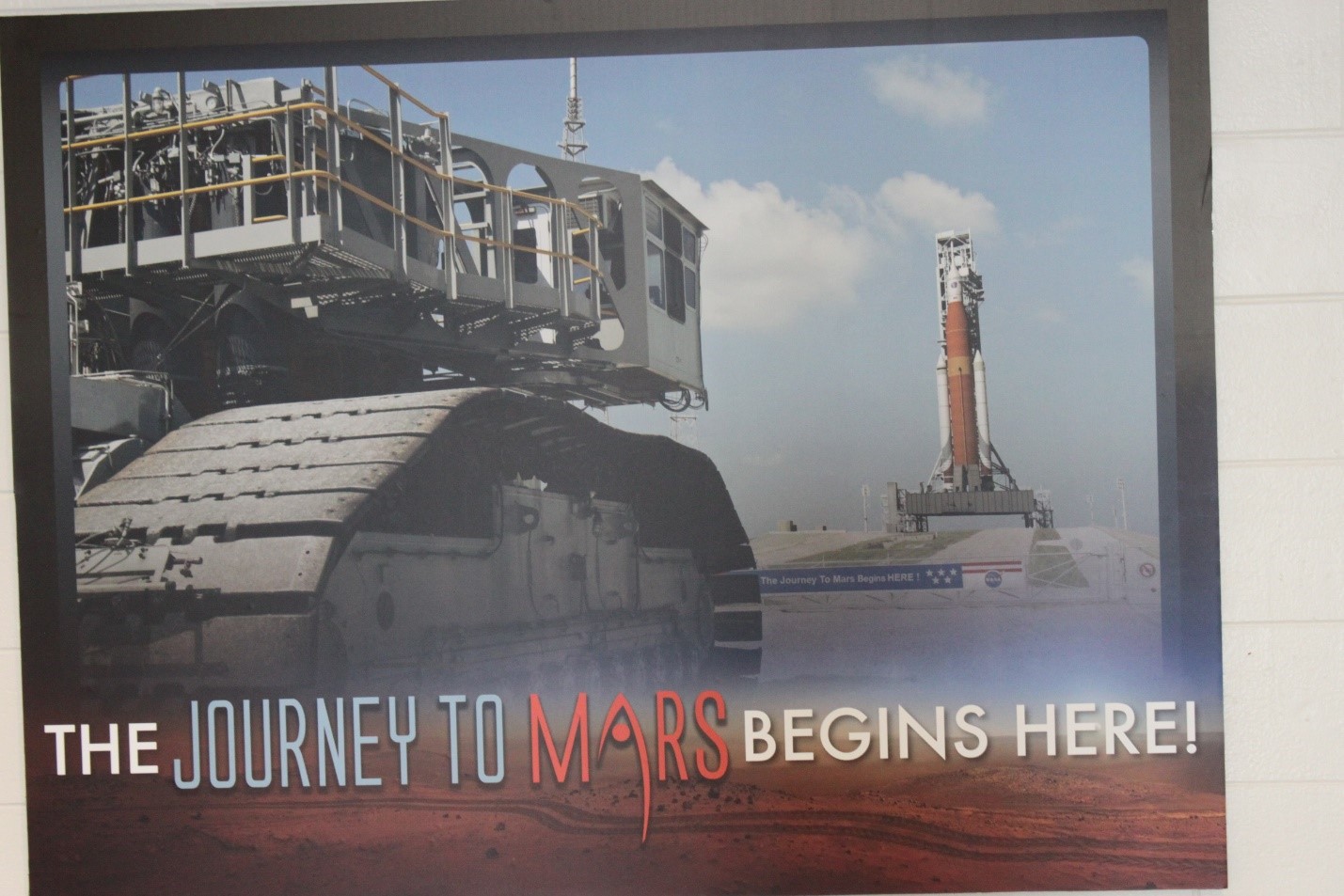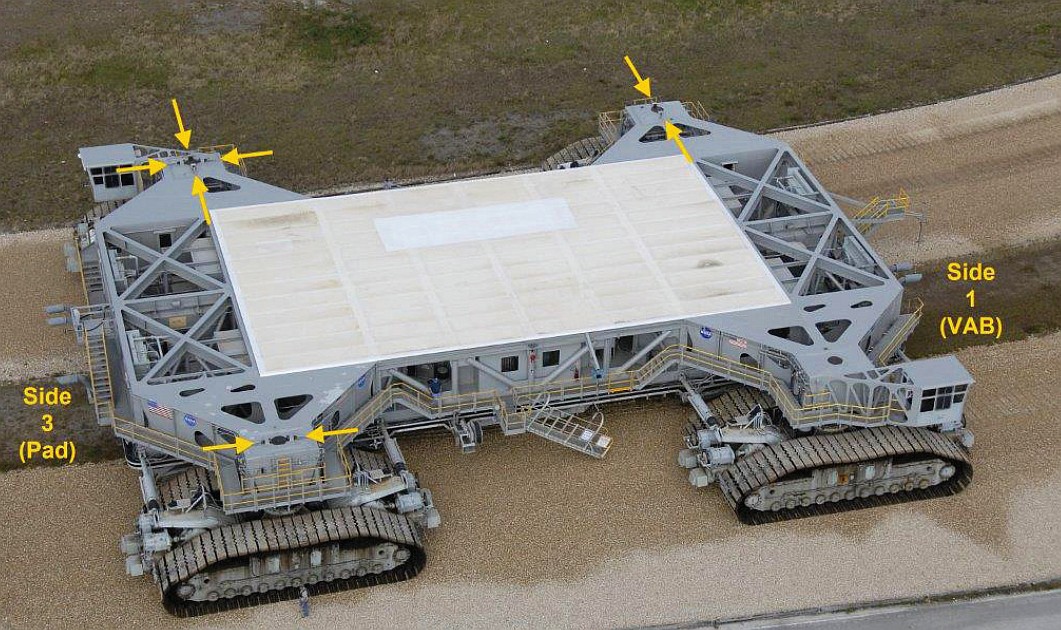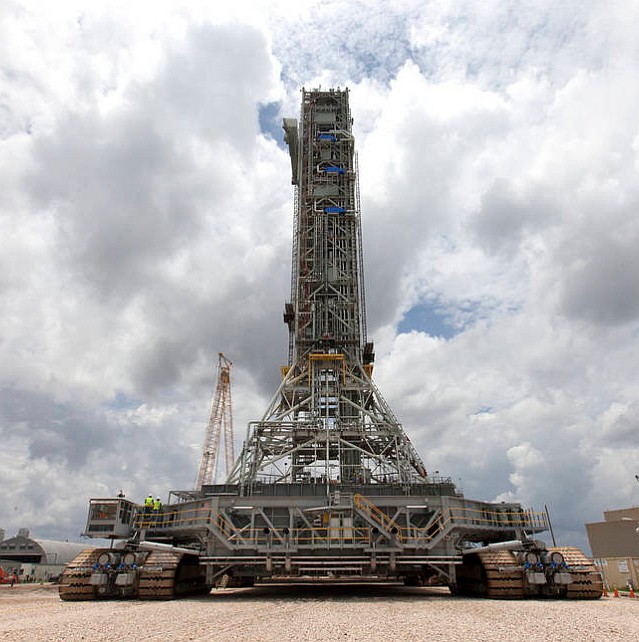
Figure 1 The Mars Orion Spacecraft will be perched atop the mighty Space Launch System (SLS) that will travel from NASA’s Vehicle Assembly Building to Launch Complex 39B via a massive Crawler-Transporter 2 moving at the speed of a sloth---one mile per hour. Artemis I will be the first launch towards our goal to land astronauts on Mars. (Image at NASA Kennedy Space Center [KSC] courtesy of Loretta Taranovich)

Figure 2 The crawler-transporter 2 has four pickup points (shown in yellow) that will be used to lift the mobile launcher (See Figure 3) with NASA’s SLS and the Orion spacecraft on top of the Crawler for its eight hour trip to Launch Complex 39B (Image courtesy of NASA)
The Crawler is 131 feet long and 113 feet wide.

Figure 3 The Mobile Launcher shown here sitting atop the Crawler-transporter 2. The vehicle’s Control Room cab can be seen on the left side just above the treads. (Image courtesy of NASA)
Some crawler history
There were two of these behemoth machines, called crawler-transporters, that have carried rockets and spacecraft to launch pads for more than 50 years at NASA’s Kennedy Space Center (KSC) in Florida. Each of these crawlers span the size of a baseball infield diamond and are powered by locomotive and large electrical power generator engines.
These crawlers were built in 1965 to move the massive Saturn V rocket, which carried the Apollo Moon spacecraft, from Kennedy Space Center’s Vehicle Assembly Building (VAB) to Launch Complex 39. After the Moon landings and Skylab programs ended, the crawlers continued to take the many space shuttles to their launch pads for the next 30 years.
After the shuttle fleet retired in 2011, the crawlers became critical elements of future launch operations at Kennedy. Crawler-Transporter 2 will be integral to the Artemis program, sending the first woman and the next man to the Moon
Crawler Facts from NASA
Weight: Approximately 6.6 million pounds (or the weight of about 15 Statues of Liberty or 1,000 pickup trucks).
Height: Varies from approximately 20 feet to 26 feet, based on the position of the jacking, equalization and leveling cylinders.
Load Capacity: Able to transport 18 million pounds (or the weight of more than 20 fully loaded 777 jet aircraft).
Aug. 26, 1967 – The first Saturn V rocket was moved to the launch pad for the unmanned Apollo 4 mission.
May 1, 1979 – A crawler transported space shuttle Enterprise, with external tank and two inert solid rocket boosters, to Launch Pad A for a fit check.
Nov. 16, 2011 – Moved Space Launch System’s (SLS) mobile launcher from the park site beside the Vehicle Assembly Building (VAB) to Launch Pad 39B.

Figure 4 A crawler could potentially lift and move the St. Louis Gateway arch weighing more than 34 million pounds! (Image at NASA KSC courtesy of Loretta Taranovich)
The newly installed generators in the crawler can each produce 1500 kW of power---that’s enough to power 17 International Space Stations (ISS)
NASA tells us that Phase I Crawler modifications, for the Artemis program, were replacement of existing roller assemblies and bearings with redesigned, upgraded assemblies and bearings which have a greater load capacity. An expanded and uprated lubrication system was added to service the new assemblies. The jacking, equalization and leveling system cylinders and piping were all replaced with redesigned and upgraded versions implemented during Phase II modifications.
Twenty-year-service life extension modifications were made, according to NASA, including a complete upgrade and modernization of the vehicle’s control room, an expanded strain and temperature system, a new condition monitoring system, two new Cummins 1,500-kilowatt AC generators, redesigned and uprated parking and service brakes, control system modifications, ALCO diesel engine refurbishments, a complete reconditioning of all gear cases and gears, and a new paint job. These additions/redesigns were done to give the crawler a longer operational life and enable this massive vehicle to carry the heavier loads anticipated with the Space Launch System (SLS) rocket.
The crawler has shoes

Figure 5 Each Crawler transporter travels on eight tracked tread belts, each of which contain 57 tread belt shoes (one tread belt shoe is outlined in orange in this image courtesy of NASA)

Figure 6 One of the tread belt shoes is shown here at Kennedy Space Center. Each one is 7.5 feet long, 1.5 feet wide, and weighs 2,100 pounds---I tried moving it----no way! (Image at NASA KSC courtesy of Loretta Taranovich)

Figure 7 Loretta and I drove by one of the transporters during our Kennedy Space Center behind the scenes trip (Image at NASA KSC courtesy of Loretta Taranovich)
A Crawler driver stands inside the Crawler cab in order to have a wider field-of-view when the vehicle is moving. There is a chair as well with three settings for sitting, leaning, and standing.

Figure 8 A 20 year crawler systems engineer/driver with United Space Alliance, Bob Myers, is shown here beside the driver console inside the Crawler cab. There are only a select few engineers certified to drive these crawlers and Myers is one of them. Shown here is the red steering wheel with a speedometer behind it. The speedometer only needs a zero to 2 mph range. A single floor pedal activates the air brake. The gauges seen on the right side of the steering wheel are indicating height, steering angle and the status of the Crawler’s Laser launch pad Docking System. A speed control knob is just to the left. (Image courtesy of NASA/KSC)
Myers commented, “A Crawler can move even the smallest distance (say, one-eighth of an inch) if it's told to. This precision is critical when it comes to delicate operations such as docking a Space Shuttle and Mobile Launcher Platform at the launch pad.”
 Steve Taranovich
Steve Taranovich
Discussions
Become a Hackaday.io Member
Create an account to leave a comment. Already have an account? Log In.